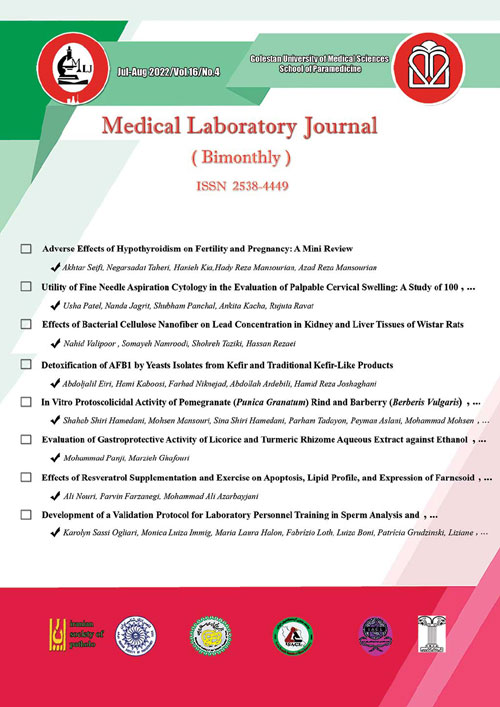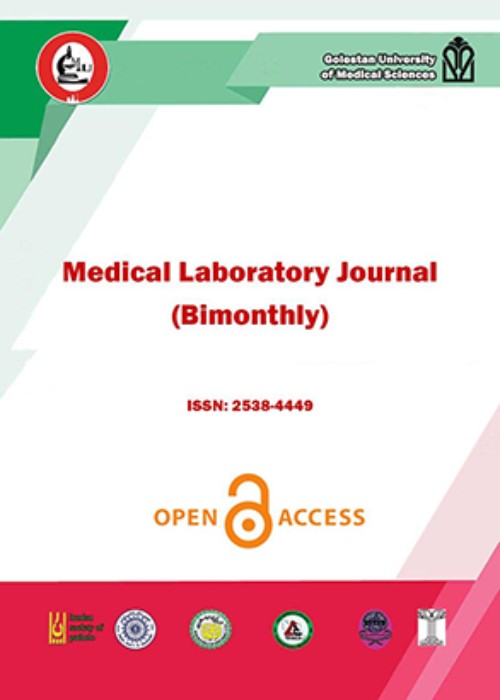فهرست مطالب

Medical Laboratory Journal
Volume:16 Issue: 4, Jul-Aug 2022
- تاریخ انتشار: 1401/04/10
- تعداد عناوین: 8
-
-
Pages 1-9
The prevalence of hypothyroidism is much higher among women than in men. Hypothyroidism is also one of the most prevalent thyroid disorders among women of reproductive age. The disease exerts its effect on female sex hormones by manipulating the production of luteinizing hormone and follicle-stimulating hormone that are crucial for the production of estrogen by the ovaries. Various studies demonstrated the adverse effect of overt hypothyroidism on ovulation, menstrual cycle, and fertility. This review surveys the adverse effects of hypothyroidism on fertility and pregnancy.
Keywords: Hypothyroidism, Thyroid hormones, Women, Infertility, Pregnancy -
Pages 10-14Background and objectives
Lesions of the head and neck region are routinely encountered by clinicians, in patients across all age groups. Diagnoses range from reactive inflammatory conditions to malignancies. Cancer is among the leading causes of death in India. Head and neck cancers account for 23% of all cancer incidents in males and 6% of all incidents in females in India,. Fine needle aspiration cytology (FNAC) of cervical masses is an easy, effective, and relatively inexpensive technique. The aim of this study was to determine occurrence of various head and neck swellings and classify them under various categories.
MethodsThe present study included 100 cases of palpable cervical swellings who had been referred to the AMC MET Medical College, Ahmedabad (India) from June 2018 to October 2020.
ResultsThe majority of cases were lymph node swellings (57%), followed by thyroid swellings (23%), salivary gland swellings (12%), and soft tissue swellings (8%). Among all cervical region swellings, tuberculous lymphadenitis and thyroid lesions were the most prevalent.
ConclusionThe findings suggest that lymph node swellings are most commonly observed in the cervical area, and that the majority of them are inflammatory, requiring medical treatment rather than surgery. Moreover, FNAC is a straightforward, quick, and cost-effective way to distinguish between non-neoplastic and metastatic malignant lesions, which could help timely surgical interventions.
Keywords: Biopsy, Fine-Needle, Tuberculosis, Lymph Nodes, Goitre -
Pages 15-19Background and objectives
Lead (Pb) is among the most toxic pollutants that affect health of both humans and animals. Finding a way to prevent Pb accumulation in animals’ bodies seems necessary. Bacterial cellulose nanofiber (BCNF) can remove heavy metals from aqueous solutions. This study investigates effects of oral consumption of BCNF, as a chelator, on Pb concentration in the kidney and liver tissues of rats.
MethodsSixteen Wistar rats (aged 6-8 weeks) were divided into four groups: 1. control, 2. fed with Pb, 3. fed with Pb (50 μg/g) and BCNF (16 μg/g) simultaneously, and 4. fed with Pb and BCNF with 4 hours interval. The rats were euthanized, and the kidney and liver tissues were separated. After acidic digestion of the tissue samples, Pb concentration was measured by atomic absorption spectrometry.
ResultsThe mean concentration of Pb in the kidney and liver tissues of rats fed with Pb and BCNF were significantly lower than that of rats fed only with Pb. In addition, the mean Pb concentration in rats of group 3 was lower than that of group 4.
ConclusionThe results of this study showed the favorable effects of BCNF on prevention of Pb accumulation in the kidney and liver tissues of rats. Moreover, removal of Pb may be related to binding of BCNF with Pb in the gut or blood. More studies are necessary to determine the exact mechanisms through which BCNF can reduce Pb accumulation.
Keywords: Rats, Wistar, Lead, Tissue -
Pages 20-25Background and objectives
Aflatoxin B1 (AFB1) is the most toxic aflatoxin produced by a large number of Aspergillus species. Successful detoxification of this toxin is an important attempt to improve community health. The aim of this study was to evaluate reducing effects of yeasts isolates from kefir and traditional kefir-like fermented beverages on AFB1 in a broth medium.
MethodsPolymerase chain reaction-sequencing was carried out to identify the yeast isolates from kefir and kefir-like beverages. Effects of the isolates on AFB1 adsorption and biotransformation in peptone dexterose broth medium were evaluated by using high performance liquid chromatography.
ResultsSaccharomyces cerevisiae and Kluyveromyces marxianus were isolated from kefir and kefir-like beverages and resulted in 46% and 53% AFB1 adsorption, respectively. The isolates 27Y and 2Y caused 7% toxin biotransformation, while 10% toxin biotransformation was achieved by the isolate 18Y.
ConclusionOur results indicate that the yeast isolates from kefir and traditional kefir-like products can bind to and detoxify AFB1, thereby reducing its harmful effects.
Keywords: Kefir, Yeasts, Aflatoxin B1, Adsorption, Biotransformation -
Pages 26-31Background and objectives
Echinococcosis is a global cosmopolitan zoonotic disease and a major veterinary and public health issue. In humans, echinococcosis usually develops following close contact with infected dogs or ingestion of the parasite eggs. Until now, no effective vaccine has been commercially developed, and treatment is only focused on controlling hydatidosis. This study was conducted to evaluate the protoscolicidal activity of alcoholic extracts of pomegranate rind and barberry.
MethodsThe alcoholic extracts of pomegranate rind and barberry were prepared by mixing 330 g of powdered plants with 1,000 ml of 70% ethanol. A concentrate of viable protoscolices (PCSs) was obtained from hydatid cysts found in the lungs and liver of sheep. Next, PCSs were treated with four different concentrations (5, 10, 20, 30, and mg/ml) of each extract for 10, 20, 30, and 60 minutes. The eosin exclusion test was performed to assess viability of the PCSs.
ResultsThe mortality rate caused by treatment with the extracts ranged between 25% and 100%. Complete inactivation of PCSs was achieved after 60 minutes of exposure to 15 mg/ml of the pomegranate rind extract and 30 mg/ml of the barberry extract.
ConclusionGiven their favorable anti-PCSs activity, combination of conventional synthetic albendazole with the alcoholic extracts of pomegranate rind and barberry might induce higher anti-PCS activity with lower side effects. It is recommended to evaluate the anti-PCSs activities of the pomegranate rind and barberry alcoholic extracts in vivo and ex vivo.
Keywords: Echinococcus granulosus, pomegranate fruit rind, Berberis -
Pages 32-38Background and objectives
Gastric ulcers occur when the mucous layer covering the gastric wall is damaged. Curcuma and licorice are famous ancient herbs that have been widely used as food additives and medicinal herbs. The present study aimed to investigate gastroprotective activity of Curcuma and licorice extract (CLE) against ethanol-induced gastric ulcers in male Wistar rats.
MethodsFifteen male Wistar rats were randomly divided into five groups and fasted for 24 hours with free access to water. The rats received different doses of CLE (200 and 500 mg/kg) or omeprazole (20 mg/kg) by oral gavage. One hour after the induction of gastric ulcer via absolute ethanol administration (5 ml/kg), the rats were sacrificed, and the stomach was opened along the greater curvature. Ulcerative lesions were observed and counted. Total juice acidity was evaluated. Finally, mRNA level of Bax and COX-2 was measured.
ResultsThe oral administration of CLE (200 and 500 mg/kg) and omeprazole (positive control, 20 mg/kg) to rats remarkably attenuated gastric acidity and the number of ethanol-induced gastric lesions. Further examination of gastric mucosal homogenate revealed significant downregulation of Bax and COX-2 in the CLE-treated groups compared with the lesion control group.
ConclusionThe findings of this study confirm the gastroprotective activity of CLE against ethanol-induced gastric injury.
Keywords: Curcuma, Stomach Ulcer, Omeprazole, Rhizome -
Pages 39-46Background and objectives
Diabetes mellitus is the most common metabolic disorder in the world. Here, we evaluated effects of resveratrol supplementation alone and combined with exercise on blood glucose, insulin, lipid profile, apoptosis biomarkers, and expression of farnesoid X receptor (Fxr), liver X receptor (Lxr), and sirtuin 1 (Sirt 1) genes in the liver of type 1 diabetic rats.
MethodsStreptozotocin was used to induce type 1 diabetes in Wistar rats. The rats were randomly assigned into seven groups. After treatment with resveratrol alone or combined with exercise training, the animals were sacrificed and lipid profile and levels of blood glucose and insulin were measured. Hepatocyte apoptosis was assessed by measuring the level of Bax and Bcl2 proteins using enzyme-linked immunosorbent assay kits. Expression of Fxr, Lxr, and Sirt1 was evaluated using real-time polymerase chain reaction. Comparison of the mean levels of all variables between different groups was performed using one-way analysis of variance, at statistical significance level of 0.05.
ResultsResveratrol significantly reduced the level of blood glucose and insulin compared with the control groups (p<0.001). It also significantly affected the lipid profile (p<0.001). Diabetes was significantly associated with decreased expression of Sirt1, Lxr, and Fxr and increased hepatocyte apoptosis. Resveratrol significantly improved the expression of all three genes (p<0.01). Overall, resveratrol supplementation combined with exercise was more effective than other methods.
ConclusionThe results indicate that that combination of resveratrol therapy with exercise could be beneficial for diabetic patients. However, more studies are needed to confirm this finding.
Keywords: Diabetes Mellitus, Resveratrol, Exercise, Apoptosis, Sirtuin 1, Liver X Receptors -
Pages 47-53Background and objectives
Semen cryopreservation is widely used in assisted reproduction techniques, and reliable semen analysis is essential to define the clinical practice. However, many parameters used for semen evaluation have high variability among technicians. Here, we describe a method of validating semen analysis prior to cryopreservation, comparing each operator’s results with an expert, and also analyzing inter-operator variability. As a second endpoint, we compare this method by analyzing semen parameters before and after cryopreservation.
MethodsFour professional trainees studied and practiced semen analysis according to the World Health Organization guidelines for one month, under supervision of an expert in the field. Next, microscopic results (sperm concentration, motility, vitality, and morphology) obtained by each team member were compared with the findings obtained by the expert.. Finally, analyzes of inter-operators were evaluated for the same parameters.
ResultsThe findings obtained by the operators and the expert did not differ significantly. Furthermore, in the inter-operator analysis, the morphology parameter differed significantly in the fresh semen sample, which was not observed in the post-thaw sample.
ConclusionOur results indicated that the laboratory staff training for semen analysis was effective, ensuring the assessment of individual performance and uniformity among operators in sperm count parameters, producing consistent results.
Keywords: Semen, Semen preservation, Cryopreservation, Validation study


